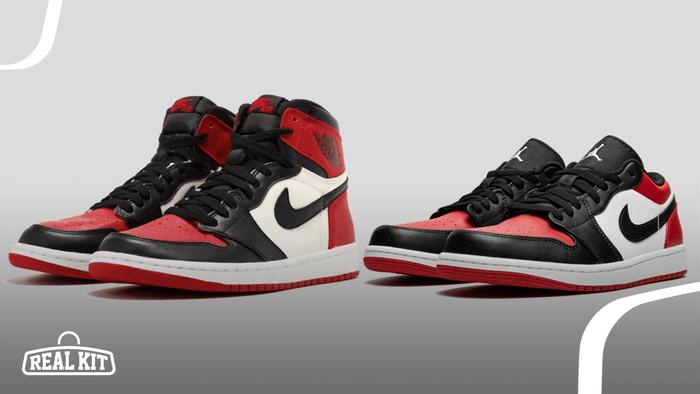Jordan 1 Low vs High: What’s The Difference?

If you’re a sneaker fan like us, you’ve probably wondered what exactly are the differences between the Jordan 1 Lows and the Jordan 1 Highs beyond just the aesthetics.
With the high-tops becoming huge fan favourites over the years, Jordan 1 Lows have never really reached the same heights of popularity as their relatives which are widely considered some of the ever made.
Despite this, Nike is still manufacturing new renditions of both the Lows, like the upcoming , and the Highs, like these , to this day.
As a result, we’ve decided to put together this guide discussing some of the key similarities and differences between the two, before giving our overall verdict on which we think you should buy.
So, without further delay, let’s dive in…
Jordan 1 Low vs High – History
Michael Jordan was selected as the third overall pick by the Chicago Bulls in the 1984 NBA draft, and by 1985, the world saw the first Nike Air Jordan 1, which has since become one of the most popular sneakers ever made.
Designed by Peter Moore, the high-top basketball shoe featured a simple Nike Dunk-inspired aesthetic that incorporated the Nike Swoosh, a new Jordan ‘Wings’ insignia, and Nike Air units in the midsoles.
Although Jordan wore the initial “Banned”, now referred to as “Bred”, high-tops on the court, thus helping them grow exponentially in popularity, it’s rarely acknowledged that the first Jordan 1 Low’s also came out at the same time.
In fact, the Jordan 1 Low originally debuted in several colorways that mirrored the high-top releases including both the Bulls-inspired and metallic designs.
Having said that, Jordan 1 Highs were the first to return out of the two in 1994, most likely due to their immense popularity, while Lows didn’t make a comeback until the early 2000s, which was ultimately towards the end of Michael Jordan’s playing career.
Jordan 1 Low vs High – Price
With the history covered, you may now be asking yourself which out of the two variations is the cheapest?
Typically speaking, low-top Jordan 1s, like the “Silver Toe” release featured in our list of the , are cheaper than their high-top relatives.
This is partly due to the extra cost of the materials required to construct the higher collars; however, perhaps the more significant reason behind the difference in price is the higher demand for Jordan 1 high-tops.
As an aside, if you’re looking for a way to keep your Jordan 1s clean, check out Crep Protect and and right here.
Jordan 1 Low vs High – Design And Comfort
The main difference to note between the low and high-tops is their collar heights, with the High measuring in at around 6.25″ from the sole to the top of the ankle collar.
Consequently, if you plan on wearing your Jordan 1s on the court, then you can expect a little more ankle support and lateral stability because of the added collar height. We discuss this in further detail in our right here.
Conversely, you may find low-tops to be less restrictive on the court which, in turn, could enhance your overall athletic performance, regardless of whether it’s purely a placebo effect or not.
It’s also important to ensure your sneakers are laced correctly for a secure lock-in. Fortunately, both High and Low Jordan 1s can be laced in almost the exact same way. For more information, check out our right here.
Ultimately, the decision on which design you prefer and which you find more comfortable will come down to personal preference.
Having said that, it’s worth keeping in mind that Run Repeats analysis of 31 academic studies found there to be no significant findings to suggest that shoe top height affects athletic performance.
Which Should You Buy?
It’s hard to say which out of the two you should buy because, in our opinion, both the Low and the High Jordan 1s have their place and purpose.
Although technically the same model, their silhouettes are far from identical, meaning they can be styled in completely different ways from a fashion standpoint.
In fact, the low-tops are more akin Air Force 1s which are widely regarded as some of the and everyday wear.
In terms of on the court performance though, we’d argue that the high-tops are a little more suited to the fast-paced action, mostly due to the added ankle support provided by the increased collar height.
As we mentioned above though, the choice all comes down to you and your personal preference, but you should now be able to come to an informed decision on which out of the two will suit you best.
Read More:




